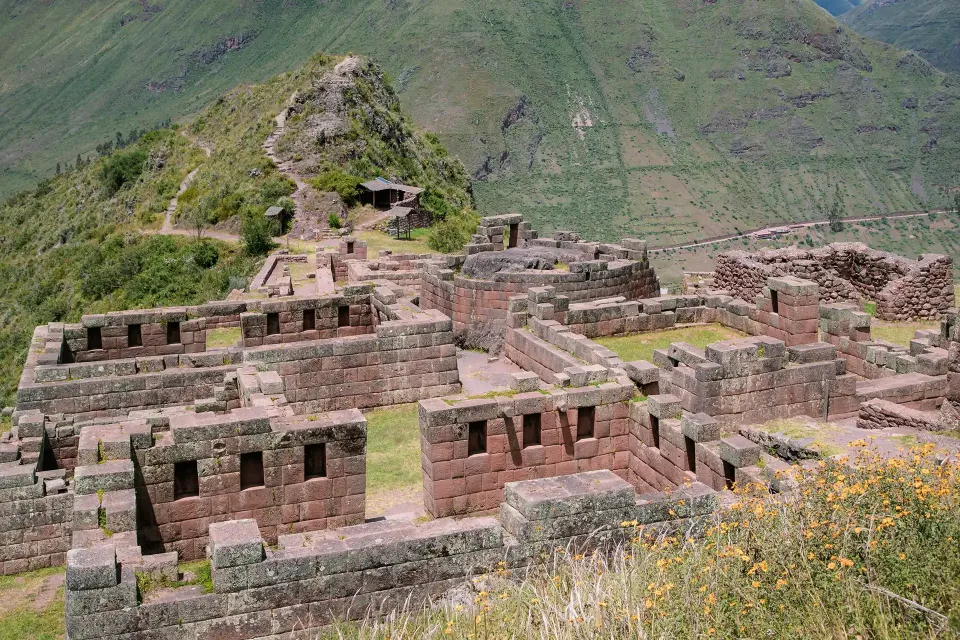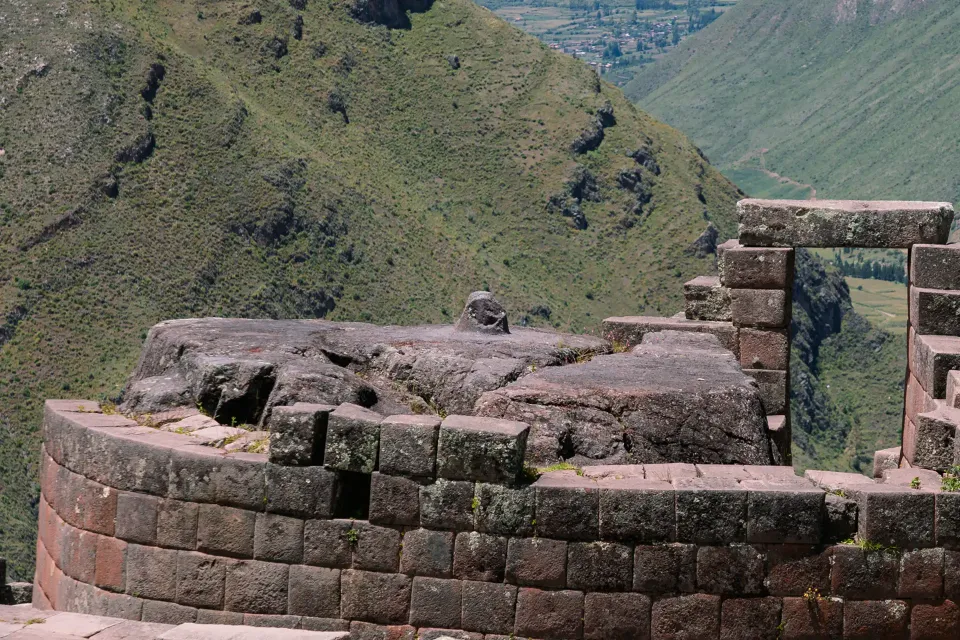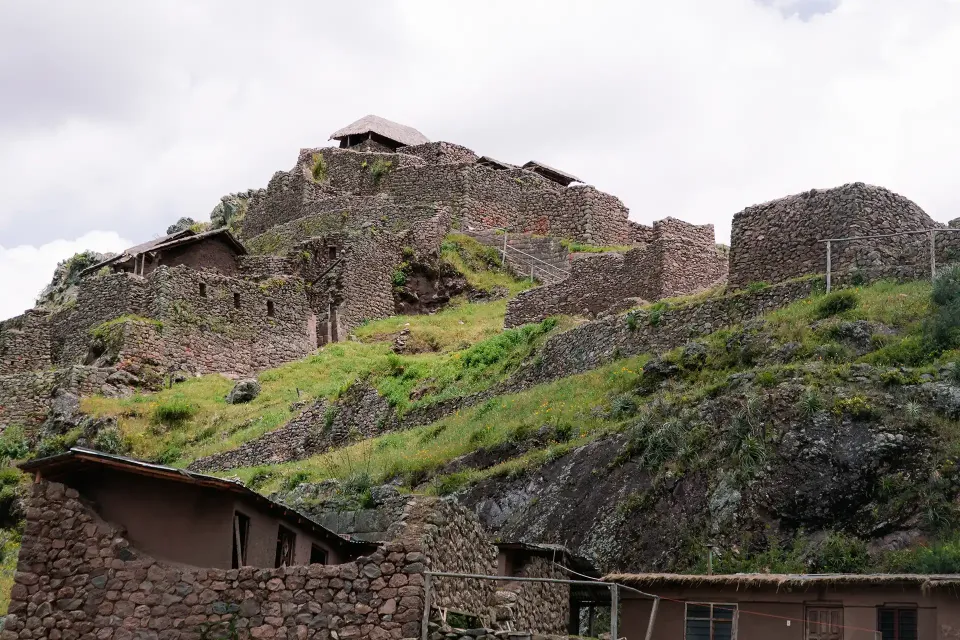Many tourists arrive at the Pisac Ruins without knowing what they are seeing. They walk along its terraces, look at the walls and at the end they leave without understanding its true meaning.
From today, when you finish reading this blog, you will see the Pisac Ruins history come alive in every step you take when you visit.
You will find Pisac just outside the city of Cusco, in the Sacred Valley of the Incas. Pisac is an ancient Inca archaeological site. It served as a civil, religious, military, and farming center. Pisac is known for its large terraces and buildings used for living, ceremonies, and other purposes. The stonework here is very impressive. The buildings blend beautifully with the surrounding landscape.
The Incas chose this spot carefully. From the top, they could watch over their lands below. Today, Pisac is a popular tourist destination because it is the gateway to the Sacred Valley and the path to the jungle.
Did you know that: The meaning of "Pisac" comes from the Quechua word "pisaqa," which means "partridge," a bird found in the area. There are many of these birds in the archaeological site. Some believe the Incas built the site to resemble this bird.
The History of Pisac Ruins
People lived in Pisac long before the Incas. Early humans from Chahuaytire left behind stone tools and rock art. Cultures like Marcavalle and Chanapata, who made pottery, influenced the area between 500 and 100 BC. Later, groups like Waru, Paqallamoco, and Qotakalli settled here.
Around 1000 to 1200 AD, the valley of Pisac became more populated. The Amaru Mayu, Pillahuasi, and Antis groups farmed the land using small terraces and lived in organized communities.
In the 15th century, during the rise of the Inca Empire, the great ruler Pachacutec built Pisac. He designed it after Cusco and used it as his personal estate, like a country retreat. Pisac was a farming center, where they grew maize and probably potatoes. This helped trade and allowed the exchange of culture between regions.
When the Spanish arrived, Pisac changed drastically. The local people fled to the highlands to escape the Spanish’s cruelty, which left Pisac mostly empty. In 1570, Viceroy Toledo ordered the resettlement of the natives and founded the town of San Pedro de Pisac.
His plan was to control the land and create a new economy focused on farming. He built the town below the ancient Inca ruins, turning Pisac into the first settlement of the Sacred Valley of the Incas.
Today, Pisac is surrounded by sacred mountains and the Vilcanota River. The famous Inca ruins sit on top of a hill, and they are one of the most important archaeological sites in the Sacred Valley. Pisac lies at the entrance of the valley, featuring ancient terraces, homes, and ceremonial areas.
Myths and Legends of Pisac
The Legend of Inquill Chumpi: Across from Pisac, you will see a rock formation known as "the enchanted ñusta." It looks like a woman with a folded hat, forever gazing at the Sacred Valley. The legend tells a sad love story between Princess Inquill Chumpi, daughter of Pisac's chief Huayllapuma, and Prince Asto Rimac. The princess had to marry the prince who could build a bridge in one night. Young Asto Rimac fell in love with the princess and accepted the challenge. While he built the bridge, Inquill had to climb the hill without looking back. But just as he was about to finish, she disobeyed and turned to look at him, turning into stone.
Pisac has many different buildings. You will see terraces, ceremonial centers, aqueducts, water channels, gates, roads, walls, and tombs. The stonework here is very well done. These buildings are strong and have lasted for many years. During Inca times, these structures were part of residential neighborhoods.
Important Attractions
The Intihuatana: The Inca Solar Calendar
The Incas carved the Intihuatana from a large rock to honor the Sun god. They used it as a solar clock or calendar to track the cycles of nature by following the sun’s position. The name "Intihuatana" means "to tie the sun." You can find it in the Intihuatana residential area, which served as a ceremonial center. This area includes beautifully constructed temples and palaces made from carefully shaped stones.
Pisaq’a Residential Area
This area contains 23 rectangular buildings arranged in a half-circle along the Chongo River gorge. The Incas built it using a simple technique called "pirka," where they stacked stones without shaping them and held them together with mud. It is the oldest part of Pisac.
Qantus Raqay Residential Area
This residential area sits at the highest part of the site. The Incas used it for homes and raising guinea pigs. They also stored food in special buildings called "qolqas." The area includes terraces, canals, and fountains, showing their advanced agricultural skills.
Qoriwayrachina Residential Area
The Qoriwayrachina area lies on the left side of the Catamayo River. The Incas built semicircular structures with large windows that attached to the rocky hillside. From here, people could enjoy wide views of the landscape.
Kallaqhasa Urban Center
The Kallaqhasa area sits on top of the mountain. This part of Pisac is the largest and highest. The Incas used it for ceremonies, living, and storing goods. They built a secret three-meter-long tunnel in this area, adding to its sense of mystery.
Ajchapata Terraces
These terraces line the Inca road that leads to Pisac. The Incas built them in a fan shape to grow crops. They made great use of the mountainside for farming.
The Towers or Pucaras
In the Qoriwayrachina area, the Incas built more than 20 towers. They used the "pucara" towers for defense and the watchtowers for keeping an eye on the surrounding area. The towers blend into the rocky landscape, offering a great view of the site and the valley below.
The Tunnels
Pisac has two tunnels carved into the rock. One tunnel is 16 meters long, and the other is 3 meters long. You can find the shorter one in the Kallaqhasa area.
Tianayoq
Tianayoq is an open area surrounded by buildings. A carved stone seat, known as "Tianayoq" or "the one with a seat," stands here. The Incas likely used this seat for ceremonies or social events.
The Cemetery of Tantanamarka
The cemetery of Tantanamarka is the largest from pre-Hispanic times. It lies in a rocky part of Pisac and has tombs carved into the stone. These tombs held both individual and group burials. Many of the tombs are visible today, though sadly, most have been looted over the years.
Visiting the Pisac Ruins: Tips and recommendations
Where is The Pisac Ruins?
Pisac is about 32 km northeast of Cusco. It sits in the Sacred Valley of the Incas, surrounded by the winding Vilcanota River.
The elevation of Pisac Ruins Cusco, Peru is 2,900 meters above sea level.
Climate of Pisac
Pisac has mild weather most of the year. The sky is usually clear, and the sun shines brightly, especially from April to November. From January to December, you can expect rainy and cloudy days. The average temperature ranges from 11 to 16 °C. The highest temperatures can reach 29 °C, while the lowest can drop to -4 °C during the winter months.
Best Time to Visit Pisac
If you want to enjoy clear skies, visit Pisac between May and September. In June, the sun is at its lowest point in the sky, offering a special connection with the site during the winter solstice.
How to Get to Pisac
- Main Route: The main road is paved and goes from Cusco to Pisac, Calca, and Urubamba. It is the fastest and most popular route, covering 30 km in about 30 minutes.
- Secondary Route: This route starts in Cusco, passes through Poroy, then Urubamba, and finally reaches Pisac. It is the longest route.
- Optional Route: This route goes from Cusco to Huambutio, passing through San Salvador before reaching Pisac. It is ideal if you like to connect with nature and the Andean landscape.
Flora and Fauna
In Pisac, you can see many types of plants native to the area. These include queuña trees, chachacomo, molle, aliso, ichu grass, and corn. Pisac is home to various animals. You might spot an Andean cat, a skunk, an Andean fox, and birds like the pisaqa and partridge.
Typical Food and Drinks of Pisac
- Lawa de Chuño: A creamy dish made from dehydrated potatoes served with meat.
- Pepian de Cuy: A type of guinea pig stew that is delicious and full of unique proteins.
- Merienda: A variety of dishes, including lamb stew, squash stew with corn cake, and a delicious baked guinea pig.
- Drink: Chicha is the most popular drink in Pisac and throughout the Cusco region
- In conclusion, the peruvian food is the best.
Cultural Festivities of Pisac
- Willa Raymi: This Andean ceremony honors Pachamama, or "Mother Earth," with reenactments featuring social figures from the Inca era.
- Papa T’ikachi: During Qorpush Christi, people surround dug-up potatoes with flowers to ensure the harvest lasts all year. They believe the potato "sleeps" or "dies," and no one works on that day.
- Patronal Feast of the Virgin of Carmen: This is the most famous and traditional festival in Pisac. It is recognized throughout the region and the country. The people of Pisac deeply express their Catholic faith during this festival.













